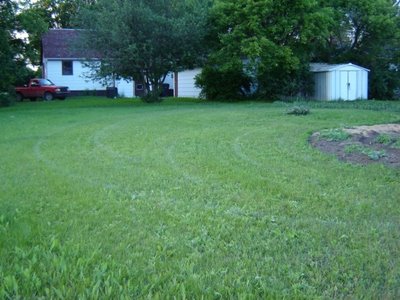
It's not really a bed, but I wanted to show you the yang side of my yin yang garden, now that I finally drew out the arcs of the labyrinth in the lawn. See the faint white lines? They're only marked with flour, so they're temporary. They are also nearly invisible when you look across the labyrinth at a low angle. When you actually walk it, you are seeing the lines close up and from above, so they show up quite well.
I walked it for the first time yesterday, and I found there was a very pleasant sense of arrival at a place of tranquillity when I reached the exit at the south end, looking out over the grassy expanse of the brick ponds. Then I walked back through it in the other direction, and found myself resisting, reluctant to follow this path back to the demands of daily life. Gradually I came to terms with it, though. When I emerged where I began, I felt a slightly uneasy thrill as I noticed that my hands were tingling. I used to get that same sensation after a good long session of Tai Chi.
I've been pausing from my gardening to gaze at it and wonder. If I remember correctly, a wide flat lawn area would actually be considered more "yin" than a gardenscape with its more complex surface including more vertical elements. Maybe the lawn part is actually the yin side. In that case, I believe I have it laid out backwards, since the yin side is supposed to lie mostly towards the south. (If you're thinking the black part of the symbol is mostly towards the top, you're right, but keep in mind that south is placed at the top of a map in Chinese traditions.) *UPDATE: Nope, I got that backwards. Yin, the black area, is mostly to the north. Feng shui expert I'm not. Here's a detailed discussion. I still haven't decided for sure which side of my labyrinth is really yin and which is yang. Maybe there's some wisdom in that.*
Oh well. This layout works better with the contour and soil conditions of my yard.
A school class might be coming to see the labyrinth tomorrow. I'll try not to talk too much about the philosophy. They might like to hear about how I made it. Here you see me marking the lines, using a rope tied to a peg to guide the "limer" (borrowed from the school) along an arc.

This arc, drawn with the rope staked at the centre of the whole design, is what I refer to as a "border arc," because it is stepped in from the border of the design. Just behind me in the picture, you can see some tighter arcs that were drawn with a rope staked at the centre of the yin dot (which is hidden behind me). I call these the yin-dot arcs. At the right edge of the picture, closer to the garden, I drew some yang-dot arcs. The only tricky part was remembering which arcs had to join up, and where, so that I didn't extend any arcs too far.
Armed with this new information, you might be able to figure out my "Labyrinth Location" codes. Some tricky points: I number the border arcs inward from the outside, but I number the dot arcs outward. Points of the clock refer to one of three different imaginary clock faces. If we are talking about a dot arc, the clock face is centred on the corresponding dot. If we are talking about a border arc, the clock face corresponds to the entire design. And finally, since south is at the top of the yin yang symbol, 12 o'clock means south. Clear as mud? Good.
I know, I need a diagram. Soon. Well, that is to say, maybe this winter.

No comments:
Post a Comment